Abstract
The application of low-cost feed additives as an immunostimulant for different species of fish is an emerging research area in aquaculture. The present study aimed at incorporating a byproduct from coffee processing, coffee silverskin, as an immunostimulant in Nile Tilapia. A total of 225 Tilapia fingerlings (each weighing 23.04±0.07) were fed on diets as follows: Diet 1 (control), Diet 2 (20 gm/kg), Diet 3 (40 gm/kg), Diet 4 (80 gm/kg) and Diet 5 (180 gm/kg) of coffee silverskin. The feeding experiment continued for four weeks; moreover, growth, as well as immunological studies, were carried out by collecting mucus and blood serum from the liver and intestine of the fish. A significant increase in growth performance was observed in fish fed with a 40 gm/kg coffee silverskin-containing diet. The same effect was found in immunological parameters, including complement activity, serum lysozyme activity, and respiratory burst activity. Therefore, it is concluded that the study was definitely a successful one, and a diet with 40 gm/kg of coffee silverskin (Diet 3) was effective, compared to the rest of the compositions.
Keywords: Coffee silverskin, Growth parameters, Serum immunology
1. Introduction
Aquaculture is reaching such a position in terms of species development that no other areas of food production could reach. Novel trends and some goals, which are yet to be achieved in the field of aquaculture, are supported wholeheartedly by the Food and Agriculture Organization. State of World Fisheries and Aquaculture (2016) has reported recently that trade in fish and fishery production has expanded worldwide giving more emphasis on fish destined for human consumption. Talking about the new trends in aquaculture, prior to discussion, is about the 2030 Agenda and its sustainable development goals. This proposal offers a world with equal rights, as well as a prosperous and more peaceful world. Along with all other goals of sustainable development, it takes into consideration a fruitful transformation in the field of aquaculture. The 2030 Agenda takes effort to take care of all the fish workers, their families, and their communities. As a part of this, the 2030 Agenda for Sustainable Development, put forward 17 goals for sustainable development in different sectors, including Aquaculture. All these goals could be achieved only if certain requirements are fulfilled. They include the establishment of a planning and management system, capacity development of institutions, and inclusion of youth and women entrepreneurs in the field of aquaculture. Tilapia is the common name given to three important genera, which are different with respect to their reproductive behavior (Tilapia, Oreochromis, and Sarotherodon). Tilapia is the third most important fish in aquaculture. Significant animal disease outbreaks lead to the hampering of the greatest potential of aquaculture that is the contribution towards food and nutrition security and eradication of poverty. The most dangerous and widespread form is the Trans Boundary Aquatic Animal Diseases, which have the potential to spread rapidly irrespective of national boundaries and may cause public health issues.
Among them are endemic diseases that consistently affect aquaculture production at the hatchery, nurseries, and grow-out facilities (e.g., bacteria, parasites, fungi, or viruses). These diseases lead to a major problem of product loss, which will adversely affect the sustainability of aquaculture. Rural areas where a provision to prevent disease outbreaks is feeble are the areas from where the lion's share of aquaculture products coming from. Even though aquaculture is the fastest-growing food production sector, we are not taking care of the biosecurity and aquatic animal health management strategies/actions/responses.
The application of low-cost feed additives in aquaculture is not a new trend, as it is one among the developing and popular parts of aquaculture. Many studies proved the efficacy of probiotics that are derived from fruits or vegetable byproducts the same as synbiotics. Coffee has become one of the most popular beverages in the world. The most popular and commercially traded species are Coffea arabica (Arabica) and Coffea canephora (Robusta). Brazil and Vietnam are the two biggest coffee producers in the world ( 1 ). Coffee processing is composed of several steps. After harvesting the coffee cherries, the pulp is removed, and green beans are obtained ( 2 ). The application of high temperature (210˚C-240˚C) to the coffee beans to transform them into brown-colored aromatic beans is the most crucial step in coffee processing which is called roasting. Silverskin or chaff in the coffee beans is obtained during the roasting process. Coffee silverskin (CSS), the byproduct of coffee bean roasting, has attractive antioxidant activity due to the presence of phenols ( 3 ). Usually, this product is thrown away due to the possibilities of air pollution and roaster cleanliness. Compared to other coffee byproducts, silverskin is the most stable due to its lower moisture content ( 3 - 5 ). Silverskin is composed of a high amount of dietary soluble fiber (~87%). It contains cellulose (18%) and hemicellulose (13%); in addition, it is composed of xylose (4.7%), arabinose (2.0%), galactose (3.8%), and mannose (2.6%) ( 4 ). Other important bioactive compounds present in CSS are chlorogenic acids (CGAs) (1%-6%) (Being 5-O-, 3-O-, and 4-O-caffeoylquinic acids the most relevant ones), caffeine (0.8%-1.25%), and Maillard reaction products formed during the roasting process, namely melanoidins (17%-23%). The composition of CSS with a significant amount of several bioactive compounds and its versatile properties, such as anti-oxidant activity, makes CSS a commercially sound product with application in the fields of the food industry, cosmetics, as well as pharmaceutical industry.
The present study aimed at evaluating the possible effects of CSS on skin mucus, serum immune responses, as well as growth performance of Nile Tilapia fingerlings. As per the searches conducted, no information is available about the effects of CSS on Nile Tilapia (Oreochromis niloticus).
2. Materials and Methods
CSS was obtained from an experimental farm, Faculty of Agriculture, Chiang Mai University, Thailand. It was dried on arrival and ground with the aid of a hammer mill, filtered, and kept tightly packed in gunny bags at room temperature.
2.1. Diet Preparation
For pellets preparation, fine ingredients were completely mixed together. Following that, soybean oil, vitamin premix, and CSS were added to produce stiff dough. The dough was thereafter passed through a pellet maker machine to form pellets, and the wet pellets were collected dried in an oven at 50°C to reduce moisture content by 10%, and stored in plastic bags at 4°C until further use. Compositions of CSS were 20 gm/kg, 40 gm/kg, 80 gm/kg, and 160 gm/kg. A control diet with zero addition of silverskin was also prepared.
2.2. Fish Preparation and Experimental Design
Fish were acclimatized in huge concrete tanks for one week and fed on a commercial diet during the acclimatization period. Prior to the initiation of the experiment, 15 fish were weighed (mean weight: 22 gm) and randomly distributed to 15 Fiberglass Reinforced Plastic tanks with a capacity of 50 liters. The duration of the experiment was 30 days. After that, the fish were hand-fed to ad libitum with diets having different compositions of silver skin, twice per day (9:00 a.m. and 5:00 p.m.). Water quality was maintained during the entire feed trial. Temperature up to 29˚C, pH from 7 to 8.3, and dissolved oxygen level not more than 6 mg per liter were considered in this study.
2.3. Sample Preparation
2.3.1. Preparation of Blood Serum and Mucus
Two fish from each tank were taken, and mucus was collected by rubbing gently and put in plastic bags containing 10 mL of 50 mM NaCl. Skin mucus was carefully transferred to 15 mL sterile tubes and centrifuged immediately at 1500×g for 5 min at 4˚C. After centrifugation, 500 μl of supernatant was carefully transferred to 2 ml tubes and kept at -80˚C until used for assays. Blood was collected simultaneously by anesthetizing the fish in the aqueous solution of clove oil (7.5 mL in 1000 mL water). Blood was collected from the caudal vein according to Van Doan, Tapingkae ( 5 ) using a 1-mL syringe and transferred immediately to Eppendorf tubes and kept at RT for 1 h, then at 4˚C for the next 3 h. Serum was isolated after this by centrifuging at 1500×g for 5 min at 4˚C. Straw-colored supernatant was carefully transferred to sterile Eppendorf tubes and kept at -80˚C until used for analysis.
2.4. Analysis of Samples
2.4.1 Immunological Analysis
2.4.1.1 Lysozyme Activity
Serum and skin mucus lysozyme activity was measured following the method of Parry, Chandan ( 6 ). The equivalent unit of the activity of the sample (compared to the standard) was determined and expressed in μgm/L serum.
2.4.1.2. Phagocytosis Activity
The phagocytosis activity was determined as described by Yoshida and Kitao ( 7 ). 200 ml of leukocyte suspension was spread over the cover slide and incubated for 2 h. The next step of washing was performed to remove non-adherent cells. 200 ml of latex bead suspension was then spread over the cover slide and again incubated for another 1.5 h. After incubation, the non-phagocyte beads were washed with RPMI 1640. Furthermore, they were washed with different stains, and the number of phagocytic cells was counted microscopically.
2.4.1.3. Peroxidase Activity
Peroxidase activity was measured according to Cordero ( 8 ).
2.4.1.4. Respiratory Burst Activity
Measurement of respiratory burst activity was determined following the method described by Secombes ( 9 ).
2.4.1.5. Alternative Complement Pathway Activity
Alternative complement pathway activity (ACH50) was determined as described by T. Yanno ( 10 ).
2.4.2. Growth Parameters
After four weeks of feeding experiments, the final weight was calculated prior to sample collection, followed by calculating the parameters, such as weight gain (WG), specific growth rate (SGR), feed conversion ratio (FCR), and survival rate (SR) 1) WG=final weight (g)-initial weight (g); 2) SGR (%)=100×(ln final weight-ln initial weight)/Duration of experiment; 3) FCR=feed offered (dried weight)/weight gain (wet weight); 4) SR (%)=(final fish number/initial fish number)×100.
2.4.3. Challenge Test
At the end of the feeding trial (4th week), 10 fish were randomly selected from each tank and injected with 0.1 mL of 0.85% normal saline solution containing 107 CFUml-1 of Aeromonas hydrophilla. The dead fish from each tank was counted and removed daily. The mortality (%) of fish in each treatment was calculated after 10 days post-challenge. Moreover, the relative percentage of survival (RPS) was computed based on the following equation Amend.
RPS=100-(test mortality/control mortality)*100
2.4.4. Statistical Analysis
The obtained data were analyzed using a SAS Computer Program for least significant differences among the treatments through the Duncan's Multiple Range Test. The data are presented as mean±standard deviation. A P-value less than 0.05 was considered statistically significant.
3. Results
3.1. Immunological Analysis
3.1.1 Serum Immune Response
The effects of dietary administration of CSS on serum non-specific immune parameters, such as serum complement activity, serum peroxidase activity, SL activity, as well as respiratory burst activity are presented in figures.
3.1.2 Serum Complement Activity
In the feeding trials with CSS, serum complement activity of O. niloticus gradually increased in the first three trials (T1, T2, and T3); however, a gradual decrease was observed in the next two trials. Graphical representation of the data is shown in figure 1.
Figure 1.
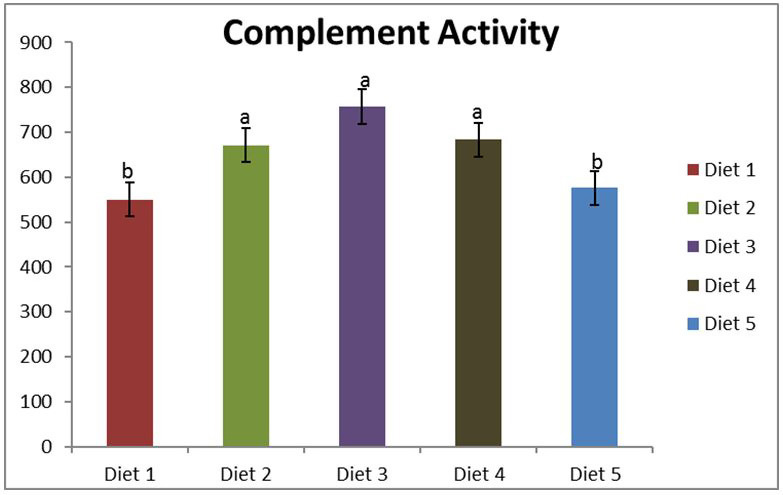
Complement activity (Units/ml) of O. niloticus fed diet containing different concentrations of coffee silverskin for four weeks (mean±SE, n=4). Significant difference at P<0.05 for groups; Diet 1: Control group, Diet 2: 20 gm CSS, Diet 3: 40 gm CSS, Diet 4: 80 gm CSS, and Diet 5: 160 gm CSS
Figure 1 complement activity (Units/ml) of O. niloticus fed diet containing different concentrations of coffee silverskin for four weeks.
3.1.3. Serum Lysozyme
The effect of CSS produced an increase in SL activity for the first three trials including the control diet. A gradual decrease in value was observed from T4 to T5. The increased value of SL (T3) is 10.412 U, while the other trials showed a decrease in the value of T3. Serum lysozyme activity (U) of O. niloticus fed diet containing different concentrations of coffee silverskin for four weeks (Figure 2).
Figure 2.
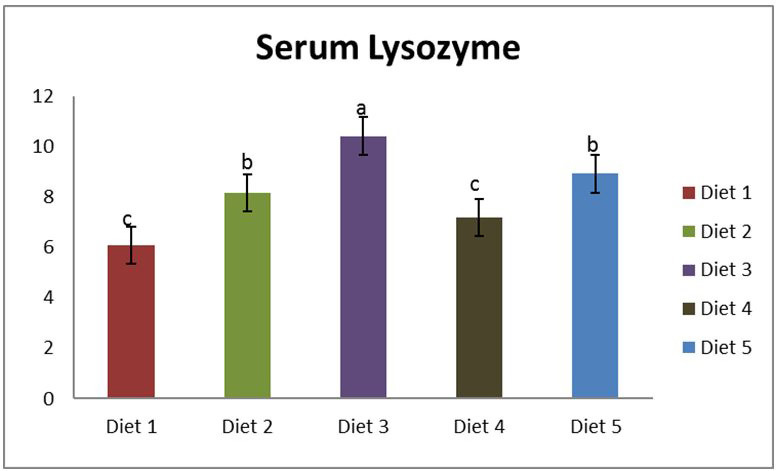
Serum lysozyme activity (U) of O. niloticus fed diet containing different concentrations of coffee silverskin for four weeks (mean±SE, n=4). Significant difference at P<0.05 for groups; Diet 1: Control group, Diet 2: 20 gm CSS, Diet 3: 40 gm CSS, Diet 4: 80 gm CSS, and Diet 5: 160 gm CSS.
3.1.4 Peroxidase Activity
Peroxidase activity of fish blood serum was found to be increasing for the first three diets, while the other two diets showed a gradual decrease in the value of T3. While observing the mucus peroxidase activity, the same scenario of gradual increase and further decrease as in serum could be found. The graphical representation of the values is given in figures 3 and 4, (Serum Peroxidase activity (Units/ml) of O. niloticus fed diet containing different concentrations of coffee silverskin for four weeks (Figure 3), Mucus Peroxidase activity (Units/ml) of O. niloticus fed diet containing different concentrations of coffee silverskin for four weeks (Figure 4)) respectively.
Figure 3.
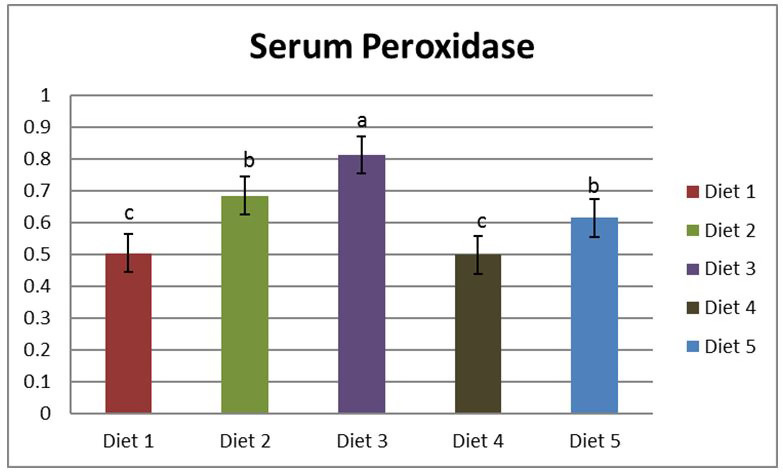
Serum Peroxidase activity (Units/ml) of O. niloticus fed diet containing different concentrations of coffee silverskin for four weeks (mean±SE, n=4). Significant difference at P<.05 for groups; Diet 1: Control group, Diet 2: 20 gm CSS, Diet 3: 40 gm CSS, Diet 4: 80 gm CSS, and Diet 5: 160 gm CSS.
Figure 4.
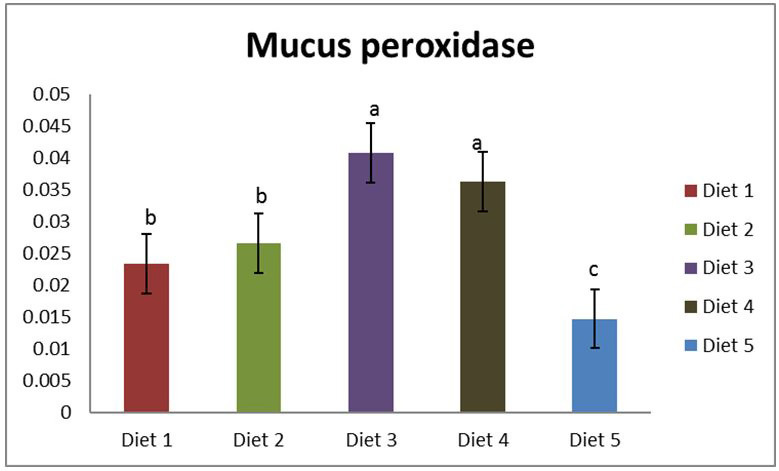
Mucus Peroxidase activity (Units/ml) of O. niloticus fed diet containing different concentrations of coffee silverskin for four weeks (mean±SE, n=4). Significant difference at P<0.05 for groups; Diet 1: Control group, Diet 2: 20gm CSS, Diet 3: 40 gm CSS, Diet 4: 80 gm CSS, and Diet 5: 160 gm CSS.
3.1.5 Respiratory Burst Activity
The effect of CSS produced an increase in serum respiratory burst activity for the first three trials including the control diet. A gradual decrease in the value was observed in T4 and T5. Nitroblue tetrazolium assay is the method used to find the respiratory burst. Figure 5 shows respiratory burst activity (Units/ml) of O. niloticus fed diet containing different concentrations of coffee silverskin for four weeks).
Figure 5.
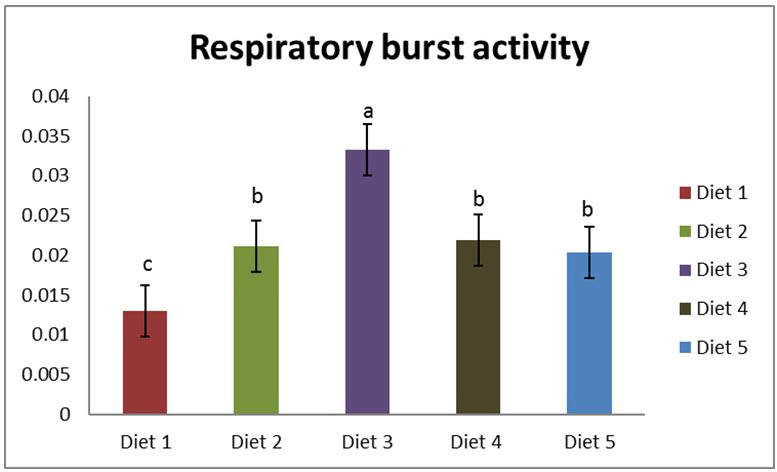
Respiratory burst activity (Units/ml) of O. niloticus fed diet containing different concentrations of coffee silverskin for four weeks (mean±SE, n=4). Significant difference at P<0.05 for groups; Diet 1: Control group, Diet 2: 20 gm CSS, Diet 3: 40 gm CSS, Diet 4: 80 gm CSS, and Diet 5: 160 gm CSS.
3.2. Growth Performance
Table 1 (Ingredients composition (%) of the experimental diets) shows the change in growth performance in Nile Tilapia after giving four weeks of feed with CSS as an immunostimulant. The table 2 (Table 2: initial weight (IW), final weight (FW), weight gain (WG), Specific Growth Rate (SGR), Feed Conversion Ratio (FCR) and Survival rate (SR) of Nile tilapia (Oreochromis niloticus) fed CSS supplemented diet for four weeks) reveals a significant weight gain and specific growth rate in the treatment group fed with 40 gm/kg of an immunostimulant. The survival rate was also found significant in the group fed with 40 gm/kg of an immunostimulant. A graphical representation of the survival rate with time is shown in figure 6. Figure 6 shows survival rate of freshwater fish O. niloticus (mean±SEM, n=4) fed experiment diets containing CSS in different levels against A. hydrophila for four weeks).
Table 1.
Ingredients composition (%) of the experimental diets
| Trials | T1 | T2 | T3 | T4 | T5 |
|---|---|---|---|---|---|
| Ingredients | |||||
| Fish meal | 270 | 270 | 270 | 270 | 270 |
| Corn meal | 200 | 200 | 200 | 200 | 200 |
| Soybean meal | 250 | 250 | 250 | 250 | 250 |
| Wheat flour | 80 | 80 | 80 | 80 | 80 |
| Rice bran | 150 | 145 | 140 | 135 | 130 |
| Coffee silverskin | 0 | 20 | 40 | 80 | 160 |
| Cellulose | 30 | 30 | 30 | 30 | 30 |
| Soybean oil | 5 | 5 | 5 | 5 | 5 |
| Premix | 10 | 10 | 10 | 10 | 10 |
| Vitamin C | 5 | 5 | 5 | 5 | 5 |
T1: control group, T2: with 20 gm CSS, T3: with 40 gm CSS, T4: with 80 gm CSS, and T5 with 160 gm CSS.
CSS: Coffee silverskin obtained from powdering the silverskin after roasting the coffee seeds
Each trial had triplicate tanks and thus total fish=5×3×15=225
Table 2.
Initial weight (IW), final weight (FW), weight gain (WG), Specific Growth Rate (SGR), Feed Conversion Ratio (FCR) and Survival rate (SR) of Nile tilapia (Oreochromis niloticus) fed CSS supplemented diet for four weeks
| Treatment | Initial Weight (gm) | Final Weight (gm) | Weight Gain (gm) | SGR (gm) | FCR (gm) | SR (gm) |
|---|---|---|---|---|---|---|
| T1 (Control) | 23.04±0.07a | 85.95±2.4b | 62.90±2.41b | 4.38±0.08b | 2.0±0.13a | 95.55±1.10b |
| T2 (20gm/kg) | 23.13±0.11a | 86.68±2.1a | 63.55±2.20b | 4.41±0.08b | 2.1±0.11a | 97.68±1.2a |
| T3 (40gm/kg) | 22.20±1.5b | 87.06±4.5a | 64.86±3.74a | 4.55±0.18a | 0.7±0.13b | 97.77±0.52a |
| T4 (80gm/kg) | 23.24±0.03a | 85.42±3.08b | 62.18±3.09b | 4.33±0.12b | 1.2±0.14b | 95.77±1.21b |
| T5 (160gm/kg) | 23.17±0.10a | 83.5±1.70c | 60.32±1.80c | 4.27±0.08c | 1.3±0.10b | 93.33±1.01c |
Different letteres of each cells have a significant difference
Figure 6.
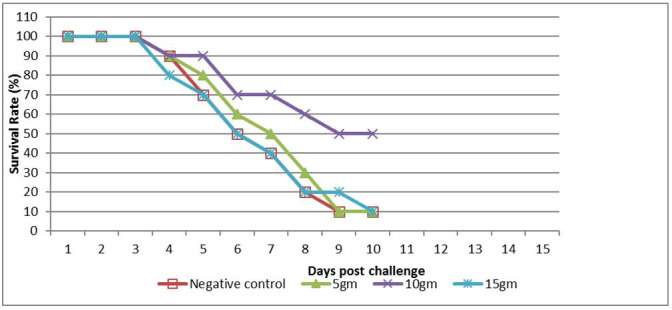
Survival rate of freshwater fish O. niloticus (mean±SEM, n=4) fed experiment diets containing CSS in different levels against A. hydrophila for four weeks
4. Discussion
Tilapia is the third most important fish in aquaculture. Significant animal disease outbreaks lead to the hampering of the greatest potential of aquaculture that is the contribution towards food and nutrition security, as well as eradication of poverty. A major trend of Tilapia production uses indoor facilities ( 11 ), and temperature should be maintained between 22°C and 29°C. Most Tilapia species are unable to survive at temperatures below 10°C, and growth is poor below 20°C. Being rich in nutritional value, Tilapia is the first choice among the popular seafood to American consumers. Tilapia is a rich source of protein, phosphorus, potassium, selenium, niacin, and vitamin B-12; moreover, it is low in fat and saturated fat, omega-3 fatty acids, calories, carbohydrates, and sodium. Furthermore, it is of significant importance not only due to the richness in nutritional value but also because of its mild taste and low expense relative to other finfish. This study used the immunostimulant to evaluate the disease resistance, immunological progress, as well as the growth performance of Nile Tilapia using coffee silver skin.
Coffee is among the most widely consumed beverages in the world ( 4 ). Although in the past, there were concerns about potential health risks of coffee and caffeine consumption raised by epidemiological research, more recently several benefits on human health have been associated with the consumption of coffee and its decaffeinated derivatives ( 12 ). Some epidemiologic and clinical studies confirmed an inverse association of coffee with all-cause mortality, and in particular, with the onset of inflammatory and cardiovascular disease, as well as type 2 diabetes ( 13 ). CGAs are also contained in different coffee by-products, such as CSS and spent coffee ( 12 ). Silverskin is a tegument of coffee beans obtained from roasting plants located in Western countries and it constitutes a by-product of the roasting procedure ( 14 ). The total amount of CGAs in silverskin is not clear since contradictory data have been reported so far. In particular, Borrelli, Esposito ( 13 ) reported a very low amount of phenol compounds (1 mg/100 g of product) in silverskin, as determined by the Folin-Ciocalteu method ( 13 ).The silverskin or the chaff is usually thrown away by the roasters due to some problems related to roaster cleanliness and air pollution. On the other hand, the silverskin is mostly used only as combustible or fertilizer ( 15 ).
However, CSS actually has the potential for antioxidant activity because it is highly rich in phenols ( 3 ). Due to its lightness, silverskin usually escapes from the roasting container through the roaster exhaust or cyclone ( 16 ). The experiments were conducted using fish blood serum, as well as fish skin mucus.
There is a significant elevation of serum immune parameters observed for these species, such as Sciaenops ocellatus ( 17 ); snakehead, Channa striata ( 18 , 19 ); African catfish, Clarias gariepinus ( 20 ); rockfish, Sebaste sschlegeli ( 21 ); pacu, Piaractus mesopotamicus ( 22 ); zebrafish, Daniorerio ( 23 ), and hybrid sturgeon, Acipenser baeri x A. schrenckii ( 24 ) that were fed with prebiotic diet.
The current study revealed that the overdose and under dose of CSS will be ineffective for fish health, and a medium level of composition is enough for better immunological, as well as other enhancements in fish. CSS is used as a fish immunostimulant for the first time. Moreover, this byproduct has been used as cattle feed for many years. According to Payne and Wilson ( 25 ) there are roughage feeds available at specific locations in the tropics, such as the waste materials from oil palm processing plants, sisal waste, pineapple waste, bagasse, cocoa pods, and coffee hulls. The feeding value of these materials varies; however, it is usually low. Microscopic examination shows the presence of fibrous tissues from the surface layers of the CSS. The main components of these fibrous tissues are cellulose and hemicellulose. Glucose, xylose, galactose, mannose, and arabinose are the monosaccharides present in CSS; moreover, glucose is found in major amounts. Proteins and extractives are also fractions present in significant amounts in this coffee waste ( 26 ).
Compared to chicken manure, there was higher weight gain with a diet consisting of pellets containing 30% of coffee pulp plus wheat bran, ground corn, molasses, cottonseed oil meal, urea, and bone meal ( 27 ). Chicken manure was similar to a control diet that did not receive any additional supplementation. The use of coffee pulp has been studied in Tilapia (Oreochromis aureus). Its use is limited by the levels of tannins, caffeine, and fiber. A dietary inclusion level of 13% coffee pulp in the diet did not affect growth and feed efficiency, compared to the control diet. Caffeine dietary levels between 2.4 and 4.6 g/kg tended to reduce fish growth, feed intake, and nutrient digestibility in Tilapia fingerlings. Bacterial inoculation was found to be a promising way to increase the nutritive value of coffee pulp for Tilapia ( 28 ).
Authors' Contribution
Study concept and design: H. V. D.
Acquisition of data: H. V. D.
Analysis and interpretation of data: P. P.
Drafting of the manuscript: H. V. D.
Critical revision of the manuscript for important intellectual content: P. P.
Statistical analysis: P. P.
Administrative, technical, and material support: P. P.
Ethics
All the ethical procedures were approved by the ethics committee of Chiang Mai University, Chiang Mai, Thailand.
Conflict of Interest
The authors declare that they have no conflict of interest.
References
- 1.Anwar I. Indonesia Coffee Market. J Assoc Indones Coffee Export Ind. 2014:1–37. [Google Scholar]
- 2.Pandey A, Soccol CR, Nigam P, Brand D, Mohan R, Roussos S. Biotechnological potential of coffee pulp and coffee husk for bioprocesses. Biochem Eng J. 2000;6(2):153–62. doi: 10.1016/s1369-703x(00)00084-x. [DOI] [PubMed] [Google Scholar]
- 3.Saenger M, Hartge EU, Werther J, Ogada T, Siagi Z. Combustion of coffee husks. Renew Energy. 2001;23(1):103–21. [Google Scholar]
- 4.Carneiro L, Silva J, Mussatto S, Roberto I, Teixeira J. Determination of total carbohydrates content in coffee industry residues. Abstracts of the 8th International Meeting of the Portuguese Carbohydrate Group. Portugal : GLUPOR: Braga; 2009. p. 94. [Google Scholar]
- 5.Van Doan H, Tapingkae W, Moonmanee T, Seepai A. Effects of low molecular weight sodium alginate on growth performance, immunity, and disease resistance of tilapia, Oreochromis niloticus. Fish Shellfish Immunol. 2016;55:186–94. doi: 10.1016/j.fsi.2016.05.034. [DOI] [PubMed] [Google Scholar]
- 6.Parry RM, Chandan RC, Shahani KM. A Rapid and Sensitive Assay of Muramidase. Proc Soc Exp Biol Med. 1965;119(2):384–6. doi: 10.3181/00379727-119-30188. [DOI] [PubMed] [Google Scholar]
- 7.Yoshida T, Kitao T. The Opsonic Effect of Specific Immune Serum on the Phagocytic and Chemiluminescent Response in Rainbow Trout, Oncorhynchus mykiss Phagocytes. Fish Pathol. 1991;26(1):29–33. [Google Scholar]
- 8.Cordero H, Cuesta A, Meseguer J, Esteban MA. Changes in the levels of humoral immune activities after storage of gilthead seabream (Sparus aurata) skin mucus. Fish Shellfish Immunol. 2016;58:500–7. doi: 10.1016/j.fsi.2016.09.059. [DOI] [PubMed] [Google Scholar]
- 9.Secombes CJ. Isolation of salmoid macrophages and analysis of their killing activity. Techniques in Fish Immunology. 1990;1: 137–55. [Google Scholar]
- 10.Yanno T. Assays of hemolitic complement activity. In: J.S. Stolen, T.C. Fletcher, D.P. Anderson, S.L. Kaatari, A.F. Roley, editors. Techniques in Fish Immunology : Tec SOS Publications; 1992. pp. 131–41. [Google Scholar]
- 11.Lim CE, Webster CD. Nutrient requirements .Tilapia: biology, culture and nutrition. Binghamton, New York : The Haworth Press; 2006. pp. 469–501. [Google Scholar]
- 12.Costa ASG, Alves RC, Vinha AF, Costa E, Costa CSG, Nunes MA, et al. Nutritional, chemical and antioxidant/pro-oxidant profiles of silverskin, a coffee roasting by-product. Food Chem. 2018;267:28–35. doi: 10.1016/j.foodchem.2017.03.106. [DOI] [PubMed] [Google Scholar]
- 13.Borrelli RC, Esposito F, Napolitano A, Ritieni A, Fogliano V. Characterization of a new potential functional ingredient: coffee silverskin. J Agric Food Chem. 2004;52(5):1338–43. doi: 10.1021/jf034974x. [DOI] [PubMed] [Google Scholar]
- 14.Louli V, Ragoussis N, Magoulas K. Recovery of phenolic antioxidants from wine industry by-products. Bioresour Technol. 2004;92(2):201–8. doi: 10.1016/j.biortech.2003.06.002. [DOI] [PubMed] [Google Scholar]
- 15.Sacchetti G, Di Mattia C, Pittia P, Mastrocola D. Effect of roasting degree, equivalent thermal effect and coffee type on the radical scavenging activity of coffee brews and their phenolic fraction. J Food Eng. 2009;90(1):74–80. [Google Scholar]
- 16.MOORE K. Instant coffee. Chemical & Engineering News Archive. 2008;86(39):42. [Google Scholar]
- 17.Zhou Q-C, Buentello JA, Gatlin DM. Effects of dietary prebiotics on growth performance, immune response and intestinal morphology of red drum (Sciaenops ocellatus) Aquaculture. 2010;309(1):253–7. [Google Scholar]
- 18.Munir MB, Hashim R, Chai YH, Marsh TL, Nor SAM. Dietary prebiotics and probiotics influence growth performance, nutrient digestibility and the expression of immune regulatory genes in snakehead (Channa striata) fingerlings. Aquaculture. 2016;460:59–68. [Google Scholar]
- 19.Munir MB, Hashim R, Nor SAM, Marsh TL. Effect of dietary prebiotics and probiotics on snakehead (Channa striata) health: Haematology and disease resistance parameters against Aeromonas hydrophila. Fish Shellfish Immunol. 2018;75:99–108. doi: 10.1016/j.fsi.2018.02.005. [DOI] [PubMed] [Google Scholar]
- 20.Romano N, Kanmani N, Ebrahimi M, Chong CM, Teh JC, Hoseinifar SH, et al. Combination of dietary pre-gelatinized starch and isomaltooligosaccharides improved pellet characteristics, subsequent feeding efficiencies and physiological status in African catfish, Clarias gariepinus, juveniles. Aquaculture. 2018;484:293–302. [Google Scholar]
- 21.Rahimnejad S, Guardiola FA, Leclercq E, Ángeles Esteban M, Castex M, Sotoudeh E, et al. Effects of dietary supplementation with Pediococcus acidilactici MA18/5M, galactooligosaccharide and their synbiotic on growth, innate immunity and disease resistance of rockfish (Sebastes schlegeli) Aquaculture. 2018;482:36–44. [Google Scholar]
- 22.Soares MP, Oliveira FC, Cardoso IL, Urbinati EC, Meldau de Campos C, Hisano H. Glucan-MOS((R)) improved growth and innate immunity in pacu stressed and experimentally infected with Aeromonas hydrophila. Fish Shellfish Immunol. 2018;73:133–40. doi: 10.1016/j.fsi.2017.11.046. [DOI] [PubMed] [Google Scholar]
- 23.Yousefi S, Hoseinifar SH, Paknejad H, Hajimoradloo A. The effects of dietary supplement of galactooligosaccharide on innate immunity, immune related genes expression and growth performance in zebrafish (Danio rerio) Fish Shellfish Immunol. 2018;73:192–6. doi: 10.1016/j.fsi.2017.12.022. [DOI] [PubMed] [Google Scholar]
- 24.Xu G, Xing W, Li T, Ma Z, Liu C, Jiang N, et al. Effects of dietary raffinose on growth, non-specific immunity, intestinal morphology and microbiome of juvenile hybrid sturgeon (Acipenser baeri Brandt female symbol x A. schrenckii Brandt male symbol) Fish Shellfish Immunol. 2018;72:237–46. doi: 10.1016/j.fsi.2017.11.001. [DOI] [PubMed] [Google Scholar]
- 25.Payne W, Wilson R. An Introduction to Animal Husbandry in the Tropics. UK: A Blackwell Publishing Ltd; 1999. [Google Scholar]
- 26.Mussatto SI, Machado EMS, Martins S, Teixeira JA. Production, Composition, and Application of Coffee and Its Industrial Residues. Food Bioproc Tech. 2011;4(5):661. [Google Scholar]
- 27.Donkoh A, Atuahene CC, Kese AG, Mensah-Asante B. The nutritional value of dried coffee pulp (DCP) in broiler chickens' diets. Animal Feed Science and Technology. 1988;22(1):139–46. [Google Scholar]
- 28.JBU R. Use of coffee pulp as feed ingredient for tilapia culture. Fish Culture and Fisheries Group: Wageningen Institute of Animal Sciences; 2002. [Google Scholar]


